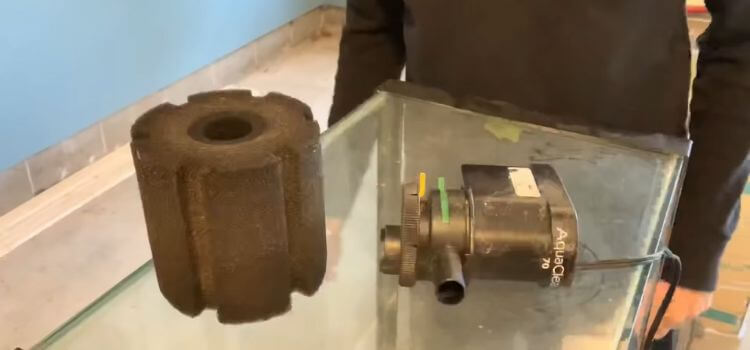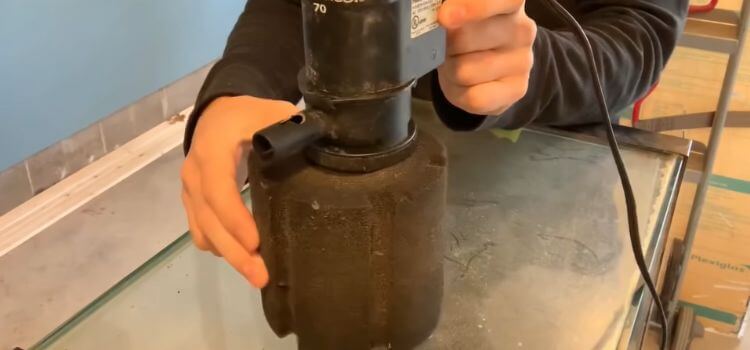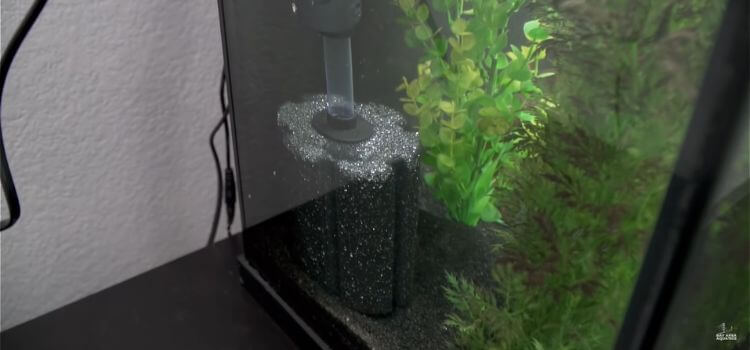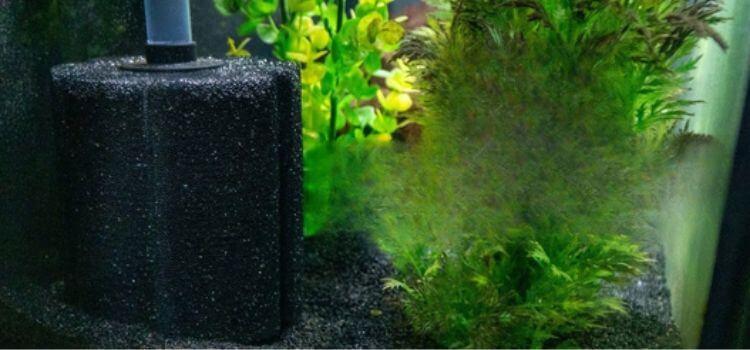As an Amazon Associate, I earn from qualifying purchases
To use a sponge filter without an air pump, simply attach the sponge filter to the water outlet of your aquarium filter or create flow by using a powerhead or water pump. Doing this allows the sponge filter to function and provide mechanical and biological filtration for your aquarium.
A sponge filter is an essential part of aquarium filtration systems as it helps maintain water quality by providing mechanical and biological filtration. Normally, sponge filters operate with the aid of an air pump to create flow. However, there are situations where using an air pump is not possible or desirable.
In such cases, alternative methods can be employed to still utilize the sponge filter effectively. We will explore how to use a sponge filter without an air pump, providing you with a simple solution for maintaining a clean and healthy aquarium environment.
Sponge Filter: An Overview
When it comes to aquarium filtration, the sponge filter is a simple and effective tool that can help to maintain the water quality for your aquatic creatures. This type of filter is often used in small to medium-sized aquariums and can be particularly beneficial for shrimp tanks and fry tanks. In this section, we will provide an overview of the sponge filter, explore its benefits, and discuss the importance of proper filtration in aquariums.
Benefits Of Using A Sponge Filter
A sponge filter offers several benefits that make it a popular choice among aquarium enthusiasts:
- Efficient Biological Filtration: The sponge inside the filter provides a large surface area for beneficial bacteria to flourish. These bacteria help to break down harmful substances such as ammonia and nitrites, ensuring a healthy environment for your aquatic pets.
- Gentle Water Flow: Unlike some other types of filters, the sponge filter produces a gentle water flow that is less likely to disturb delicate creatures like fry or shrimp. This makes it an ideal option for breeding tanks or tanks with sensitive species.
- No Noise or Vibrations: A sponge filter operates silently, without any vibrations that could potentially stress out your aquatic pets. This makes it a suitable choice for use in bedrooms or areas where noise reduction is desired.
- Affordability and Easy Maintenance: Sponge filters are relatively inexpensive compared to other filtration systems. They are easy to clean and maintain, requiring only occasional rinsing of the sponge to remove debris.
Importance Of Proper Filtration In Aquariums
Proper filtration is crucial for the health and well-being of your aquarium inhabitants. Here are a few reasons why you should prioritize filtration in your tank:
- Removal of Toxins: A reliable filtration system helps to remove harmful substances such as ammonia, nitrites, and nitrates from the water. These toxins can build up and become detrimental to the health of your aquatic pets, leading to stress, disease, or even death.
- Promotion of Oxygenation: Filtration aids in the oxygenation of the water, providing a vital element for the survival of your fish and other aquatic creatures. Proper oxygenation ensures that your pets can breathe easily and thrive in their environment.
- Prevention of Algae Growth: By effectively filtering out excess nutrients and waste, an efficient filtration system can help to prevent the overgrowth of algae in your aquarium. Algae blooms can be unsightly and may negatively impact the water quality and the overall aesthetics of your tank.
- Maintenance of Water Balance: Filtration plays a crucial role in maintaining the overall water balance, including pH and hardness levels. Keeping these parameters stable is essential for the health and breeding success of many fish species.
As you can see, the sponge filter offers numerous benefits and ensures proper filtration in your aquarium. By providing efficient biological filtration, gentle water flow, and easy maintenance, this type of filter can create a healthy and thriving aquatic environment for your pets. Remember to prioritize proper filtration in your aquarium setup to keep your aquatic creatures happy and healthy.
Alternative Methods Of Aeration

Sponge filters can be used without an air pump through the method of natural aeration. Placing the sponge filter in a tank with adequate surface agitation, such as with a power head or by using a DIY waterfall filter, can effectively oxygenate the water.
This alternative aeration method is cost-effective and easy to implement.
Exploring Options For Aeration Without An Air Pump
When it comes to keeping your aquarium ecosystem healthy and thriving, adequate aeration is essential. While air pumps are a popular choice for providing oxygenation and water circulation, there are alternative methods you can explore to achieve the same results. In this article, we will delve into DIY aeration methods for aquariums that don’t require an air pump. Let’s discover how you can maintain a well-oxygenated and vibrant aquarium without the need for additional equipment.
Diy Aeration Methods For Aquariums
If you’re looking for cost-effective and eco-friendly ways to aerate your aquarium without an air pump, there are several simple DIY techniques you can try. These alternative methods not only provide oxygenation but also create a visually appealing underwater environment for your aquatic pets.
1. Utilize Natural Airstones
One popular DIY option for aeration involves using natural airstones. Airstones are porous rocks that release small bubbles when submerged in water, creating oxygenation and water movement. You can easily find these natural airstones at aquarium supply stores or even in your backyard if you have access to specific types of rocks. Simply rinse the airstones thoroughly and place them strategically in your aquarium. The interaction between the airstones and water will promote the exchange of gases, ensuring a well-aerated aquatic environment.
2. Employ Aquatic Plants
Aquatic plants are not only aesthetically pleasing but also serve as natural oxygenators. They play a crucial role in the oxygen-carbon dioxide cycle by absorbing carbon dioxide during the day and releasing oxygen through photosynthesis. Adding a variety of underwater plants to your aquarium not only enhances its visual appeal but also contributes to its overall aeration. Consider including plants such as Anubias, Hornwort, or Amazon Sword plants, which are known for their remarkable oxygenating capabilities.
3. Opt For Surface Agitation
Surface agitation is another effective way to enhance aeration in your aquarium. By creating ripples or waves on the water surface, you facilitate the exchange of gases between the air and the water. You can achieve surface agitation by creating a small waterfall effect using rocks or aeration devices such as a sponge filter or a fountain attachment. Not only does this technique increase oxygenation, but it also adds a captivating and dynamic element to your aquarium.
4. Increase Water Surface Area
Increasing the water surface area is a simple yet efficient way to improve aeration without an air pump. If your aquarium has a tight-fitting lid, consider removing it or replacing it with a mesh or netting material. This allows for better gas exchange between the water and the surrounding air. Additionally, positioning the water outlet from your filter near the water surface helps maximize aeration as the water cascades back into the tank.
By exploring these alternative methods of aeration, you can ensure that your aquarium species thrive in a well-oxygenated and healthy environment, without relying on an air pump. Experiment with these DIY techniques and find the ones that work best for your specific tank setup. With a little creativity and resourcefulness, you can create a stunning aquatic ecosystem that keeps your underwater friends happy and healthy.
Using A Sponge Filter Without An Air Pump
Using a sponge filter without an air pump can be an effective way to maintain a healthy aquarium environment. While air pumps are commonly used to power sponge filters, there are alternative methods to ensure proper filtration without the need for constant air supply. In this guide, we will explore the process of setting up and maintaining a sponge filter without an air pump, as well as tips for choosing the right sponge filter for your aquarium.
Choosing The Right Sponge Filter
When selecting a sponge filter for use without an air pump, it’s crucial to consider the size and capacity of your aquarium. Choose a sponge filter that is appropriately sized for your tank and capable of providing adequate filtration without the need for additional air supply. Look for a filter with a strong suction base to ensure stability within the aquarium.
Setting Up The Sponge Filter Without An Air Pump
To set up a sponge filter without an air pump, begin by securing the filter in the desired location within the aquarium. Attach the suction cup to the bottom of the filter before placing it in the tank. Ensure that the sponge is fully immersed in the water, allowing for efficient filtration. The natural water movement within the aquarium will facilitate the flow of water through the sponge without the aid of an air pump.
Maintenance And Care Tips For A Sponge Filter Without An Air Pump
Regular maintenance is essential to ensure proper functionality of a sponge filter without an air pump. Clean the sponge filter regularly by rinsing it in dechlorinated water to remove debris and detritus. Check the filter for any clogs or blockages, and replace the sponge if it becomes excessively dirty or worn. Monitor the water quality to ensure that the sponge filter is effectively maintaining a healthy aquatic environment.
Tips For Maximizing Efficiency

When it comes to utilizing a sponge filter without air pump, there are a few key tips that can help you maximize its efficiency. By optimizing water flow, managing waste and debris, and ensuring proper maintenance, you can keep your aquarium clean and healthy. In this article, we will explore these tips in detail.
Optimizing Water Flow In The Absence Of An Air Pump
Without the assistance of an air pump, it is essential to find alternative methods to optimize water flow in your sponge filter. One effective way to achieve this is by positioning the filter sponge correctly. Placing it near the water outlet or water flow direction of your tank can help maximize circulation. Additionally, consider adjusting the sponge density. A denser sponge will create a stronger water flow, while a lighter one will allow for a gentler current. Experiment with different sponge densities to find the ideal flow rate for your aquarium.
In addition to sponge placement and density, regularly cleaning your filter sponge is crucial for maintaining efficient water flow. Remove accumulated debris and sludge from the sponge using clean water, squeezing it gently to prevent clogging. Remember, a clogged sponge can significantly impact water flow, which can in turn affect the overall filtration process.
Managing Waste And Debris Without Traditional Aeration
Traditional aeration plays a vital role in removing waste and debris from aquariums. However, when using a sponge filter without an air pump, it is necessary to find alternative methods to manage these unwanted particles. Here are some useful strategies:
- Mechanical removal: Regularly use a siphon to remove excess waste, such as uneaten food and fish waste, from the bottom of your tank. This manual cleaning method can reduce the load on your sponge filter.
- Biological filtration: Encourage the growth of beneficial bacteria in your sponge filter by providing ample surface area. Adding additional biological media, such as ceramic rings or bio-balls, can enhance the filter’s ability to break down organic waste.
- Chemical filtration: Consider utilizing activated carbon or other chemical filtration media in your aquarium setup. These substances can help remove odors, chemicals, and impurities from the water, complementing the sponge filter’s mechanical and biological filtration.
By following these strategies and regularly monitoring your aquarium’s waste levels, you can ensure that your sponge filter effectively manages waste and debris without the need for traditional aeration.
Ensuring Proper Maintenance For Sustained Efficiency
Proper maintenance is essential for sustaining the efficiency of a sponge filter without an air pump. Regularly inspect and clean the sponge to prevent clogging and maintain optimal filtration performance. Additionally, monitor water parameters, such as ammonia, nitrite, and nitrate levels, to ensure the overall health of your aquarium. Conduct partial water changes to maintain water quality and remove accumulated toxins.
Remember, a well-maintained sponge filter will provide reliable biological and mechanical filtration, keeping your tank clean and providing a healthy environment for your aquatic companions.
Troubleshooting And Common Concerns

Using a sponge filter without air pump can present some challenges, but with the right knowledge and solutions, you can overcome them effortlessly. In this section, we will address the common concerns and troubleshooting techniques that come with using a sponge filter without an air pump. We understand that you may have questions about this topic, so we have also included a frequently asked questions section to provide expert solutions to your queries.
Addressing Challenges When Using A Sponge Filter Without Air Pump
When it comes to using a sponge filter without an air pump, certain challenges can arise. However, understanding these difficulties and their solutions will help you ensure the efficient functioning of your sponge filter.
Common Concerns And Solutions:
Here are some common concerns you may encounter when using a sponge filter without an air pump, along with expert solutions:
No Water Flow:
If you notice that there is no water flow from your sponge filter, check the following:
- Ensure that the sponge filter is properly installed in your aquarium.
- Confirm that the sponge is not clogged with debris or excess waste.
- Check if the air valve is closed, as this can restrict water flow.
Poor Water Circulation:
In case of poor water circulation, follow these steps:
- Verify if the sponge filter is positioned correctly in your aquarium.
- Check the sponge for any blockages or accumulated waste, and clean it if necessary.
- Consider adding a powerhead or a small water pump to improve circulation in your tank.
Insufficient Oxygenation:
If oxygenation is a concern, try these solutions:
- Strike a balance between the number of sponge filters and the size of your aquarium.
- Place the sponge filter near the surface of the water to increase oxygen exchange.
- Ensure the sponge filter is not smothered by excess debris, as this can limit oxygenation.
Frequently Asked Questions On How To Use Sponge Filter Without Air Pump
How often should I clean my sponge filter?
Cleaning your sponge filter once a month is usually sufficient. However, if you notice a significant reduction in water flow or the sponge becomes heavily clogged, it may require more frequent cleaning.
Can I run a sponge filter without an air pump overnight?
Yes, you can safely run a sponge filter without an air pump overnight. The sponge filter will continue providing biological filtration, ensuring a healthy environment for your aquatic pets.
How Does A Sponge Filter Work Without An Air Pump?
The sponge filter operates by using an air pump to create a flow of water through the sponge. In the absence of an air pump, the filter can still function by relying on the natural flow of water in the aquarium.
The sponge acts as a filter media, trapping debris and providing a surface for beneficial bacteria to grow.
Can A Sponge Filter Be Used In A Low-tech Aquarium Setup?
Yes, a sponge filter is ideal for low-tech aquarium setups. It can provide mechanical and biological filtration without the need for electricity or a complicated setup. The sponge filter is a reliable and cost-effective option for maintaining good water quality in a low-tech aquarium.
What Are The Benefits Of Using A Sponge Filter Without An Air Pump?
Using a sponge filter without an air pump has several benefits. It promotes a gentle flow of water, suitable for delicate fish and fry. It provides excellent biological filtration, helping to establish a stable nitrogen cycle. Additionally, it is energy-efficient and operates silently, making it a popular choice for aquarium enthusiasts.
Can I use a sponge filter without an air pump in a large aquarium?
Yes, you can. However, it is recommended to use multiple sponge filters or consider complementing your filtration system with a powerhead or water pump to ensure adequate water circulation and oxygenation.
Will a sponge filter without an air pump be sufficient for my heavily stocked tank?
While a sponge filter can offer biological filtration, a heavily stocked tank may benefit from additional filtration methods. You might want to consider combining a sponge filter with a hang-on-back filter or a canister filter for optimal results.
Conclusion
Using a sponge filter without an air pump is a cost-effective and low-maintenance solution for aquarium filtration. By following the outlined steps, you can significantly improve water quality for your aquatic pets. With this simple yet effective method, you can create a healthy and thriving aquatic environment.
As an Amazon Associate, I earn from qualifying purchases

